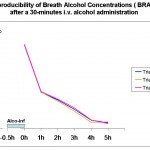Usefulness of the methods
The majority of ambulant patients taking drugs consume relevant amounts of alcohol. As these patients often cannot manage every-day-life without driving cars or operating complicated/ dangerous machinery, the testing of drug-ethanol interactions is of great social and socio-economic importance and remains a significant topic in the process of drug approval by the health authorities world-wide. Synergistic (e.g. with benzodiazepines, opiates, antihistamines, etc.) as well as antagonistic (e. g. with selective serotonin re-uptake inhibitors/ SSRI) interactions can be observed (see fig. 2).
Principle of the methods
Administration of ethanol:
Ethanol is given by intravenous infusion. This results in blood ethanol concentrations with low intra- and inter-individual variations (see figure 1 left, mean alcohol elimination in 3 different trials) in contrast to the oral alcohol administration with a relevant absorption deficit (ranging from 30 to 50%).Continuous monitoring over the whole test period is carried out by measurement of the breath alcohol concentration (BRAC). Thus also a steady-state alcohol concentration might be titrated or maintained by this method.
(see figure 1 left, mean alcohol elimination in 3 different trials) in contrast to the oral alcohol administration with a relevant absorption deficit (ranging from 30 to 50%).Continuous monitoring over the whole test period is carried out by measurement of the breath alcohol concentration (BRAC). Thus also a steady-state alcohol concentration might be titrated or maintained by this method.
Measurements:
We have designed a system of multidimensional tests (ODT, CRT, PTT, AEP, EEG, etc.), which are able to assess the multitude of CNS dysfunctions which are usually initiated by intake of alcohol. These tests are presented in more detail below.
Reference data
Data are available for cyclic antidepressants, SSRIs, encephalotropics, benzodiazepine and non-benzodiazepine type of anxiolytics, surfactants.
Advantages of the methods
The test systems:
Car driving simulators – which satisfactorily mimic the demands of daily driving in traffic – are mostly too complex and also subject to motivational and learning effects, thus complicating the evaluation of relevant parameters. Therefore, in our experimental setting, a pursuit tracking test (PTT) – which measures eye-hand coordination (for synergistic and antagonistic alcohol effects see figure 2 left with different ADs), as required for car driving – is combined with the ODT (oculodynamic test, testing saccadic eye movements and complex choice reaction task/CRT), which has the outstanding feature that there is no influence by motivation and learning – especially on saccadic eye movements.
(PTT) – which measures eye-hand coordination (for synergistic and antagonistic alcohol effects see figure 2 left with different ADs), as required for car driving – is combined with the ODT (oculodynamic test, testing saccadic eye movements and complex choice reaction task/CRT), which has the outstanding feature that there is no influence by motivation and learning – especially on saccadic eye movements.
Administration of ethanol:
Oral administration of ethanol, due to tremendous intra-individual differences in velocity and quantity of absorption, results in erratic influences on CNS- and psychomotor performance and on application of defined/ reproducible blood alcohol concentrations (BAC). Therefore in our experiments ethanol is given by intravenous infusion, to assure absolute bioavailability of ethanol, thus resulting in exact blood levels (exact titration as well as maintenance/ steady-state of BAC – if needed).
Options
- Evidence/ exclusion of pharmacodynamic interactions of drugs primarily acting on the CNS with ethanol (e.g. antidepressants, antiepileptics, anxiolytics)
- Evidence/ exclusion of pd-interactions of drugs – potentially acting on CNS with ethanol – as a side effect (AEs, e.g. with antihypertensives, spasmolytics, NSAIDs, hypolepemics, H2-blockers, proton pump inhibitors etc.)
- Evidence of an antagonism to the ethanol effect on performance (e.g. of selective serotonin re-uptake inhibitors/ SSRIs)